Eggplant is a very tender warm season perennial grown as an annual. Grow eggplant in the warmest, frost-free time of the year. The edible fruit can be long and slender or round or egg-shaped fruit. The fruit is creamy-white, yellow, brown, purple, or sometimes almost black.
Eggplant is a small- to medium-sized bush vegetable that produces smooth, glossy-skinned fruit that can vary in length from 5 to 12 inches (12-30cm) long. Eggplants have large, fuzzy, grayish-green leaves and produce star-shaped lavender flowers with yellow centers.
Eggplants can grow 2 to 6 feet tall (.6-1.8m), depending on the variety.
Related articles:
- Eight Ways to Cook and Serve Eggplant
- Eggplant Seed Starting Tips
- How to Harvest and Store Eggplant
- Eggplant Growing Problems Troubleshooting
- How to Plant and Grow Eggplant
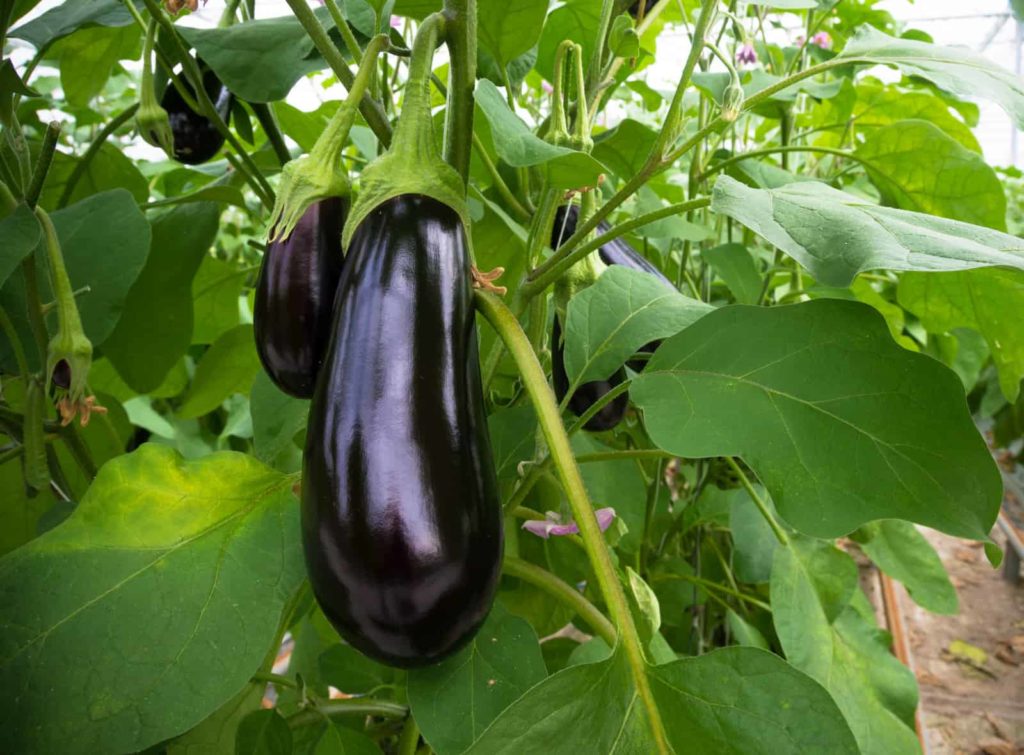
Eggplant is a very tender warm season perennial grown as an annual. Grow eggplant in the warmest, frost-free time of the year. The edible fruit can be long and slender or round or egg-shaped fruit. The fruit is creamy-white, yellow, brown, purple, or sometimes almost black.
Eggplant is a small- to medium-sized bush vegetable that produces smooth, glossy-skinned fruit that can vary in length from 5 to 12 inches (12-30cm) long. Eggplants have large, fuzzy, grayish-green leaves and produce star-shaped lavender flowers with yellow centers.
Eggplants can grow 2 to 6 feet tall (.6-1.8m), depending on the variety.
Good Products for Growing Eggplant:
- Espoma Garden Tone 3-4-4 Fertilizer
- Epsom Salt Plus Plant Nutrients Magriculture
- Tomato Grower’s Answer Book
- Neem Bliss 100-% Cold Pressed Neem Oil
- Safer Brand Insect Killing Soap
- Monterey BT Caterpillar Killer
- Southern Ag Liquid Copper Fungicide
Here is your complete guide to growing eggplant!
Eggplant growing tips
- Eggplants grow 18 to 36 inches tall and 24 to 36 inches wide. Each plant produces 3 to 4 well-developed fruits weighing up to 2 pounds each.
- Eggplants require a long growing season of 100 to 140 warm days with air temperatures consistently between 70° and 90°F (21-32°C) to reach harvest.
- Eggplant is best started indoors and later transplanted into the garden; sow eggplant indoors 6 to 8 weeks before the last frost date or the time you plan to set plants into the garden.
- Transplant seedlings into the garden no sooner than 2 to 3 weeks after the last frost in spring.
- Eggplants planted too early will not develop.
- Eggplant yield: plant 1 to 2 eggplants per household member.
Starting eggplant indoors
Eggplants are commonly set in the garden as transplants; start seed indoors 8 to 12 weeks before you plan to set plants out in the garden, or buy eggplant seedlings or starts—already 8 weeks old or more–ready for transplanting from a garden center.
Transplant eggplant outdoors when the daytime air temperature average at least 70°F (21°C) and night temperatures remain above 55°F (13ºC). In cool regions, use row covers to control the air temperature or warm the soil by covering it with black plastic.
- Start eggplants from seed indoors about 8 weeks before setting seedlings in the garden.
- Sow seed in individual containers or flats. Sow eggplant seed ¼ to ½ inch (12mm) deep and spaced 4 to 5 inches (10-12cm) apart. Sow seeds in a moistened seed starting mix. Place a plastic dome or plastic wrap over the seed starting tray to retain warmth and moisture until seedlings emerge.
- Eggplant seeds germinate in about 5 to 6 days.
- Give seedlings started indoors 12 hours of light each day; use a grow light or fluorescent lights.
- Start seeds on a heat mat then grow seedlings at about 70°F (21°C).
- Transfer seedlings to 4-inch (10cm) pots when seedlings are 3 to 4 inches (7-10cm) tall and then into gallon containers if the weather does not allow transplanting as seedlings grow 5 to 6 inches (12-15cm) tall or taller.
- Place seedlings under a grow light for 10 hours a day; turn plants every other day so that they grow tall and straight.
- Ahead of transplanting, lay black plastic across garden planting beds to pre-warm the soil.
- An alternative to starting eggplants from seed is to purchase plants 6 to 8 weeks old at the garden center.
More tips: Eggplant Seed Starting
Good Products for Growing Your Garden
- 55 Heirloom Vegetable Varieties–27,500 Non GMO Seeds
- Heirloom Vegetable Seed Collection – 105 Varieties
- Full Spectrum, LED Grow Lights
- Seed Starter Kit with Humidity Dome (120 Cells Total Tray)
- Galvanized Raised Garden Bed with Cover
- Gardzen 10-Pack 10 Gallon Grow Bags
- Captain Jack’s Dead Bug Brew
- Harris Neem Oil Plant Disease Control
- Freeze Protection Garden Mesh Netting Kit
- Kitchen Garden Grower’s Guide Vegetable Encyclopedia
- Vegetable Garden Almanac & Planner
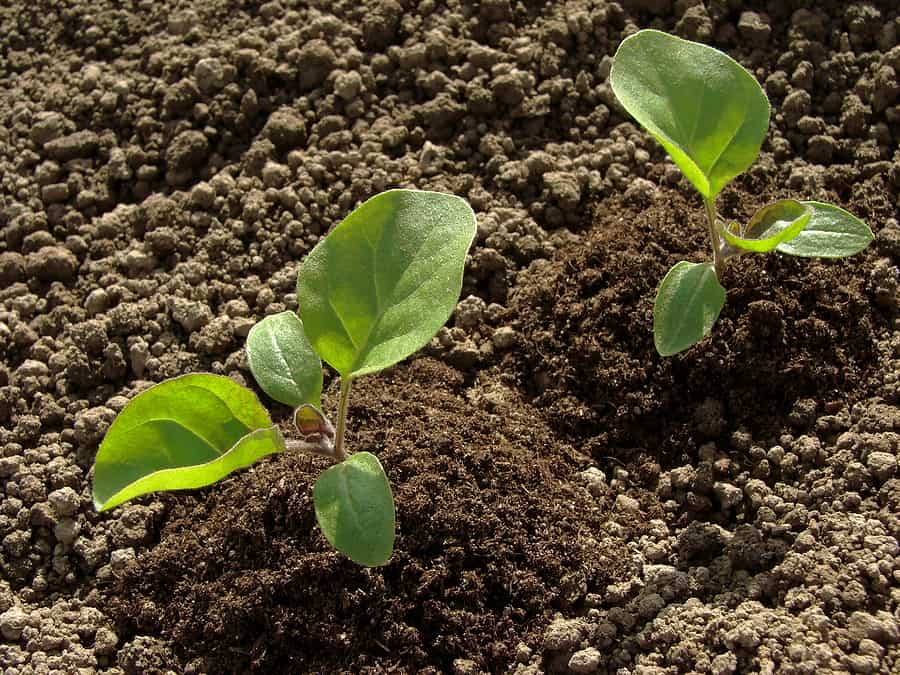
Where to plant eggplant
Grow eggplant in full sun. In hot regions where the temperature tops 100°F (38°C), it’s best to protect plants with shade covers. Avoid cool locations because eggplant blossoms will drop if temperatures fall below 50°F (10°C). Eggplant is a very tender vegetable that grows best in growing zones 5–12. It will grow as a perennial in growing zones 10 and 11.
Eggplant prefers light, humus-rich, well-drained, warm soil. If planted in early spring, eggplant grows best in light sandy soils; loam is preferred for later crops. In high rainfall regions or in areas with poor drainage, grow eggplant in raised beds.
- Grow eggplants in a sunny location. Ten hours of sunlight each day is essential for the best growth.
- Eggplants grow best in loamy soil or sandy loam that is rich in organic matter and well-drained. Add aged compost or commercial organic planting mix to planting beds ahead of planting and turn the soil to 12 inches (30cm) deep.
- Eggplants prefer a soil pH of 5.5 to 6.8. Perform a soil test ahead of plating to know the soil pH.
- Warm the soil in advance of planting by laying black plastic over planting beds for two weeks.
Transplanting eggplant into the garden
Set eggplants in the garden 2 to 3 weeks after the last frost in spring when the soil has reached 60°F. Start seed indoors 8 weeks before setting plants in the garden; use bottom heat to keep starts at 80°F until they are established. Do not rush setting eggplants in the garden; temperatures too low will only stress eggplant and decrease the yield or kill the plants.
- Transplant eggplants into the garden 2 to 3 weeks after the last spring frost. Warm soil is essential for young plants to become established.
- Harden off seedlings before transplanting them in the garden; set them outdoors in a sunny spot for an hour or two the first day, then increase the time outdoors each day so that they become acclimatized.
- Make a planting hole twice the width of the root ball and half again as deep. Moisten the hole before transplanting.
- Sprinkle a 5-10-5 or 5-10-10 organic fertilizer in the bottom of the hole and cover lightly with aged compost or planting mix. Then set the seedling in place.
- Set eggplant seedlings into the garden at the same depth they are growing in their containers.
- Firm the soil around the root ball and gently water the plant. Create a small basin around the seedling to direct water to the roots at watering time.
- Set a stake or small tomato cage in place to support the plant as it grows. Eggplants loaded with fruit can tip or fall over; it’s best to support them.
Spacing eggplants
- Do not crowd eggplants. Space plants 24 to 36 inches (61-91cm) apart–about 2 square feet per plant. Check the seed packet for the mature size of the variety or cultivars you are growing. Space rows 24 to 36 inches apart.
- Be sure plants are well-spaced to allow for good air circulation which is essential for fruit ripening and to discourage pests and diseases.
- Protect young plants with polyethylene floating row covers if days or nights are cool. Lift row covers during warm afternoons so that bees can pollinate plants.
Container growing eggplant
Eggplant will grow in a container at least 12 inches (30 cm) deep; choose a space-saving variety. Grow eggplant in containers in short-season regions where containers will retain heat and can be moved to protected locations when temperatures cool.
- Eggplants are easily grown in containers.
- Grow eggplants in pots at least 12 inches (30cm) across and as deep. Choose a smaller growing variety for container growing.
- Be sure to keep the potting soil just moist throughout the season. Do not let the soil dry out.
- Feed eggplants in containers every two to three weeks with compost tea or a dilute solution of fish emulsion.
- Container-grown eggplants are easily moved out of cold weather; so you can extend the season in spring and autumn by moving plants indoors when frost threatens.
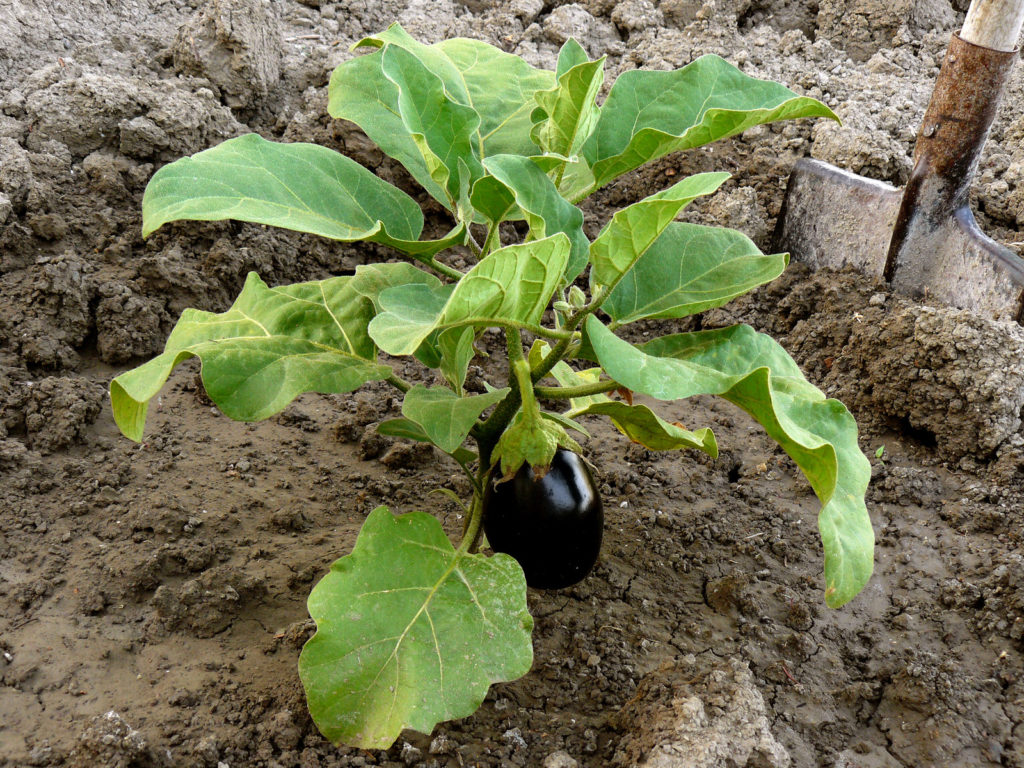
Watering eggplant
Keep the soil around eggplants moist. Soak the soil deeply using water basins around each plant. Poor blossom set and fruit color may be caused by low soil moisture. Use organic compost mulch to keep the soil moist and free of weeds.
Eggplants do not demand as much water as peppers and tomatoes. Water eggplant seedlings early to establish roots, but when plants flower and set fruit a deep watering once a week is sufficient. Eggplants are drought tolerant; too much water can hinder fruit development. In very hot regions, mulch eggplants keep roots from overheating.
- Eggplants require evenly moist soil to ensure the best and fastest growth. Do not allow the soil to dry out and do not overwater.
- Set drip irrigation or a soaker hose in place after transplanting seedlings to the garden. Give plants at least 1 inch of water every week.
- Inconsistent soil moisture can result in misshapen fruits.
- After the soil has warmed to 70°F (21°C), mulch around eggplants to retain soil moisture and to keep down weeds.
- Water plants in the early morning on a sunny day.
- Avoid overhead irrigation which can leave plants susceptible to fungal diseases.
- Check the soil every day or two in late summer to be sure the soil does not go dry; thrust your index finger into the soil; if it comes away dry, water the plants.
- A bitter flavor is often the result of plants being water stressed.
Feeding eggplant
Wait to feed eggplants until after they have flowered and set fruit; earlier feeding will only boost leaf growth, not fruit growth. After the fruit set, simply feed eggplants with a side-dressing of aged steer manure or aged compost, or spray them with fish emulsion. Feeding eggplants before fruit set will delay the harvest.
Eggplants require moderate amounts of nitrogen and high amounts of potassium and phosphorus. Feed eggplant every 3–4 weeks with fish emulsion or compost tea to deliver these nutrients.
- Eggplants are heavy feeders.
- Prepare planting beds by adding aged compost and well-rotted organic mulch.
- Side-dress eggplants with compost tea or a dilute solution of fish emulsion every 2 or 3 weeks until the fruit has set and then every 3 to 4 weeks after.
Eggplant companion plants
Eggplants grow well with all beans, peas, peppers, potatoes, and southern peas. Avoid growing eggplant with corn, fennel, and tomatoes. Avoid planting eggplants where peppers, tomatoes, potatoes, or other eggplants were grown during the past 2 years.
- Plant eggplants with bush beans, southern peas, and nitrogen-fixing crops. Do not plant eggplant with tomatoes or corn.
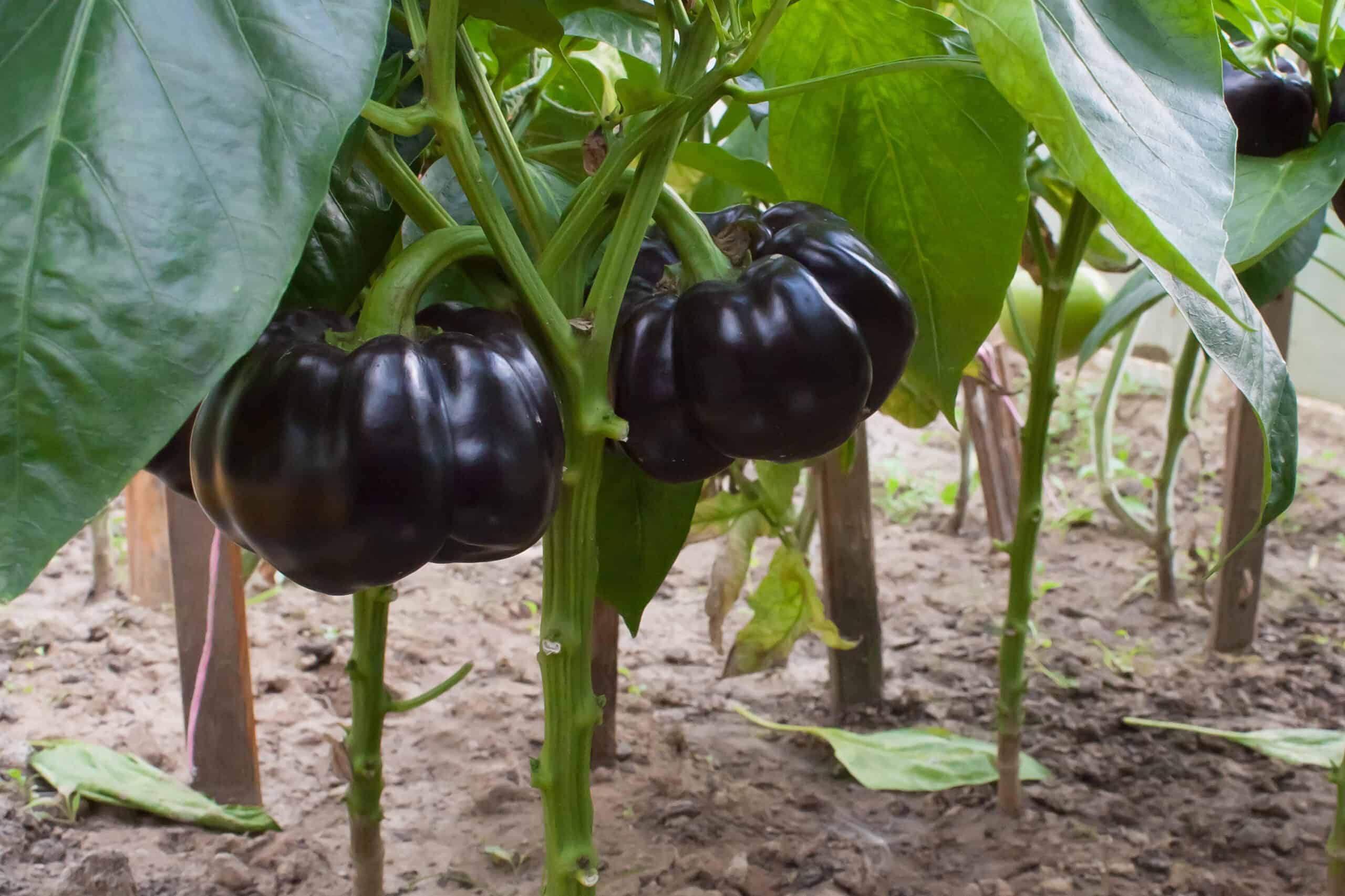
Eggplant care
Much of eggplant growing success has to do with care. Eggplants demand even, regular water. Even one missed watering and the yield will likely suffer. Eggplants need 2 to 3 gallons of water per plant each week. A regulated drip irrigation system will ensure proper watering. After plants are established, mulch around eggplants to maintain and conserve soil moisture. After fruits have set, feed plants every two weeks with compost tea or fish emulsion.
- Protect eggplants from an unexpected late frost. Provide protection at night until all danger of frost is past. Cover the plant with spun poly floating row covers.
- Chilly weather and lack of moisture can inhibit pollination.
- In hot weather, the soil temperature may become too warm for the roots; mulch plants about 4 weeks after setting them in the garden. Use aged compost or grass clippings to mulch around eggplants in summer.
- Where temperatures grow hot in the summer to 100°F (37°C) or greater, protect eggplants with shade covering.
- Tall varieties and those with heavy fruit should be staked or caged.
Eggplant pests
Aphids, beetles, cutworms, and other insect pests can attack eggplants. Use row covers to deter insect pests or apply a light dusting of ground limestone to the plants. Place collars around eggplants at the time of transplanting to discourage cutworms.
As crops develop, exclude pests with cloches or row covers. Eggplants should be strong enough to go it alone 3 to 4 weeks after transplanting. Exclude cutworms with paper collars and flea beetles with row covers. Do not allow weeds to grow near eggplants.
- Eggplants can be attacked by cutworms, aphids, flea beetles, Colorado potato bugs, spider mites, and tomato hornworms.
- Cutworms eat young plant stems just below the soil surface. Move the soil to uncover cutworms. Set collars around the plants at the time of transplanting.
- Flea beetles eat tiny holes in eggplant leaves. Spray eggplant flea beetles with neem soil.
- Tomato hornworms are large caterpillars that eat large sections of leaves. Handpick hornworms off the plants or spray with Bacillus thuringiensis.
- Colorado potato beetles and their larvae will skeletonize leaves. They can be removed by hand or sprayed with insecticidal soap.
- Aphids, whiteflies, and spider mites also suck juices from leaves. Hose them off the plant and pinch out infested areas. Spray the infestation with insecticidal soap or Spinosad.
- Spider mites can be difficult to control; use an insecticidal soap spray.
Protect eggplants: Eggplant Growing Problems: Troubleshooting.
Eggplant diseases
Several viruses and fungi can plague eggplant. Plant resistant varieties, clear debris from the garden, and use a 3-year crop rotation to combat disease.
- Eggplant is susceptible to fungal and bacterial diseases and also viral diseases.
- Planting disease-resistant varieties when possible.
- Keep the garden clean of debris.
- Bacterial wilt, southern blight, and Verticillium wilt can cause eggplants to wilt.
- Bacterial wilt can not be cured; plants wilt and a brown slime will ooze from the stem. Remove and place plants in the trash.
- Southern blight is a fungal disease that spreads in hot, moist weather. Leaves turn pale and fall off and mold may appear around the base of the plants; remove the plants and place them in the trash.
- Verticillium wilt causes wilting on one side of the plant; spray-mist leaves with compost tea to prevent and slow fungal diseases.
- Anthracnose is a fruit-rot fungus that causes round depressed areas in the thin asking; removed infected fruit and place it in the trash.
- Diseased plants should be removed immediately before the disease spreads to healthy plants.
- Protect the plants against soil-borne disease by rotating corps; do not plant eggplant family members including tomatoes, potatoes, and peppers in the same spot two seasons in a row.
Eggplant problem prevention
Here are ways to prevent eggplant problems from the beginning of the season until the end:
- Before planting spread black plastic to prewarm the soil.
- At the time of planting, encircle each young plant with a cutworm collar.
- Cover plants with a floating row cover and seal the edges to exclude insects or spray plants with kaolin clay to discourage flea beetles.
- Protect eggplants from chilly nights with cloches or row covers until reliable warm weather arrives; then remove protection.
- Weed carefully around young plants to avoid root damage.
- Apply an organic mulch when the soil has warmed.
- Use a sharp knife or garden shears to cut eggplant fruit off plants without breaking the stems.
- After harvest, if Verticillium wilt is a problem, remove all plant tops and roots from the garden.
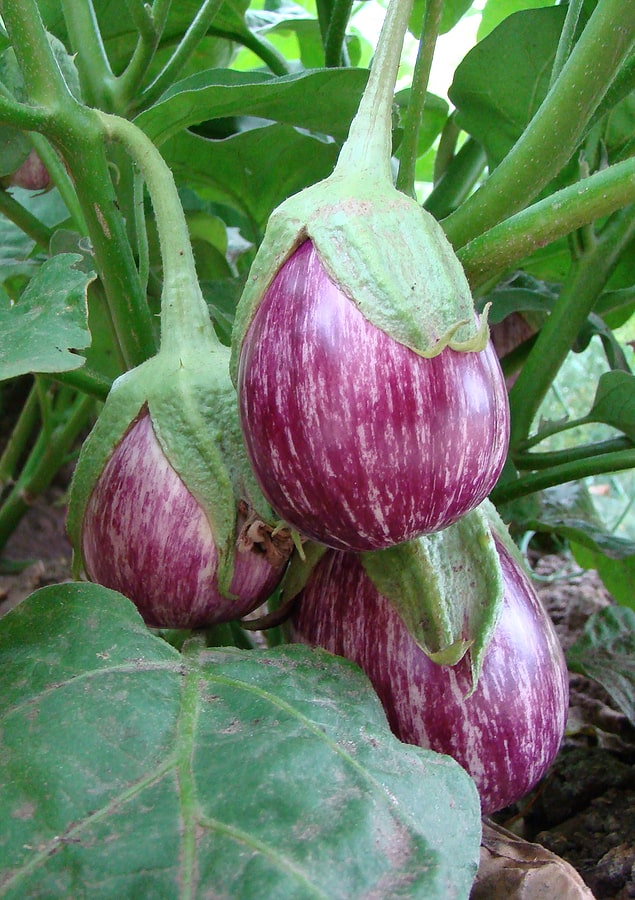
Eggplant harvest
Pick eggplant when shiny, firm, and full-colored. Mature fruit is soft enough that thumb pressure will leave an indentation in the flesh of the fruit. Use shears to clip the fruit with the stem attached. Harvest eggplant regularly to encourage further fruiting. Each plant usually produces 3–4 well-developed fruits.
For the best flavor, pick eggplants early, young, and tender. ‘Baby’ eggplants are sweeter tasting than mature eggplants. Pick fruits when the skins are glossy and shiny; an overripe eggplant has dull skin. Overripe eggplant will be seedy and bitter tasting. The easiest way to harvest eggplant is to use a pruning shear; cut the fruit away with a little bit of stem attached to the fruit.
Know the harvest size of the eggplant variety you are growing; eggplants mature at anywhere from 2 to 10 inches long depending upon the variety. Start the harvest when the fruit is half its mature size. Press the skin with your finger; if the skin springs back, it is time to pick. Use a sharp knife or pruner to cut eggplants from the stem. Do not pull an eggplant from its stem.
- The time to harvest fruit is 100 to 150 days from sowing seed and 70 to 85 days from planting transplants. Fruit production and harvest can be slowed by cloudy or cool days during the growing season.
- Eggplants are ready for harvest and will have the best flavor when the fruit is firm and full-colored with glossy skin.
- Eggplants with no seeds are immature. Fruits with hard, dark seeds are overripe.
- Eggplants that are under or overripe will have a bitter taste.
- Cut eggplants from the stem with a pruning shear or sharp knife. Leave a short stub of stem about 2 inches long attached to the fruit. Wear gloves when harvesting eggplant fruits; there can be sharp thorns around the stems and calyx.
Harvest tips: How to Harvest and Store Eggplant.
Eggplant kitchen use
Try any color of eggplant stuffed with chopped tomatoes, onions, and garlic cooked in olive oil. This tasty dish is called “The Iman Fainted.” It seems an Iman married a beautiful young girl who brought eggplant and olive oil as part of her dowry. Every night after they were married, she served the Iman stuffed eggplant. When the eggplant was gone, the husband asked his new wife where his favorite meal was. When she explained they had run out of eggplant, the Iman fainted.
- Eggplant is served cooked: baked, grilled, stewed, and deep-fried.
- Serve eggplant with cheese, tomatoes, onions, and meats.
- The French use eggplant in a vegetable stew called ratatouille, with tomatoes, onions, peppers, garlic, and herbs.
- Eggplant is a key ingredient in the Greek moussaka, layered with ground meat and topped with bechamel sauce.
- Baba ghanoush is finely chopped roasted eggplant, olive oil, lemon juice, various seasonings, and tahini. The eggplant is usually baked or broiled over an open flame before peeling.
- Coat eggplant slices in breadcrumbs and deep-fry them.
- To remove excess moisture from eggplant slices before you cook them, salt them liberally, let them stand for about half an hour, wash them, and pat the dry. Or weigh down the slices with a heavy plate to squeeze out the moisture.
- A one-pound fresh eggplant contains 117 calories–about 76 when cooked, 1 gram of fat, 28 carbohydrates, 992 mg of potassium, and 387 international units of Vitamin A.
Storing and preserving eggplant
- Eggplants will keep in a well-ventilated place for up to 1 week at 50°F (10°C) or slightly warmer.
- It is best not to refrigerate eggplant but if you do wrap the fruit in plastic to prevent cold burn. Do not wash or cut eggplants before refrigerating.
- Eggplant can be frozen or dried.
Eggplant varieties to grow
Choose from these eggplant types and varieties: ‘Black Beauty’ the classic purple-skinned variety; ‘Dusky’ is purple, and ‘Rosa Bianca’, an heirloom with white skin and lavender streaks. There are also many Asian eggplant varieties.
Classic eggplant varieties to grow are:
- Black Beauty: grows glossy black, bell-shaped fruit 4 to 6 inches (10-15cm) long; about 6 fruits per plant; the plant grows 18 to 24 inches tall; heirloom variety; harvest 74 days after transplanting
- Easter Egg: small pastel yellow or orange fruits the size of an egg.
- Galine: hybrid black bell to 6 inches long; grows well in cool to warm summer regions; 65 days.
- Gretel: white fruit about 4 inches long; sweet and tender; All-American Selection.
- Green Knight: jade green fruit to 7 inches long; the plant grows to 36 inches high; hybrid.
- Ichiban: grow slim, deep purple fruits 6 inches (15cm) plus long.
- Listada De Gandia: fruit is purple with white stripes to 8 inches long; mild flavor, thin skin; 80 days.
- Little Fingers: small, dark purple skin, 3 to 4 inches (7-10cm) long.
- Michal: black fruit with few seeds; grows well in tunnel or greenhouse; 70 days.
- Millionaire Purple: about 8 inches long, thin, purple fruit; hybrid cultivar.
- Pot Black: compact plant for container growing; no bitter taste; 60 days.
- Purple Blaze: purple fruit with white streaks; grows to 20 inches; 4-inch fruit.
- Ping Tung Long: bright purple fruit to 9 inches long with slight curve; 2 inches wide; open-pollinated; 65 days.
- White Star Hybrid: white fruit to 7 inches long; lacks the bitterness of purple varieties; the plant grows to 36 inches tall.
Here’s a full list of eggplant varieties to grow (there are a range of sizes to choose from):
- Bell-shaped eggplant: Black Beauty (73-80 days); Black Bell (68 days); Blacknite (61 days); Imperial Black Beauty (80 days).
- Long, cylindrical eggplant: Agora (68 days); Dusky (61 days); Ichiban (60 days); Millionaire (55 days); Osaka Honnoga (65 days); Slim Jim (65 days); Tycoon (54 days); Vernal (70 days); Violetta di Firenze (65 days); Vittoria (61 days).
- Small eggplants: Bambino (45 days); Mini Fingers (68 days).
- Non-purple eggplants: Alba (60 days); Casper (70 days); Easter Egg (60 days); Italian Pink (75 days); Listada de Gandia (75 days); Louisiana Long Green (100 days); Osterei (80 days); Rosa Bianca (75 days); Turkish Italian Orange (85 days); White Beauty (70 days).
Eggplant varieties by days to maturity
Grow an eggplant variety suited to the number of days in your region that can match the soil and air temperatures eggplants demand. Choose a short-season eggplant if the number of consecutive days of very warm temperatures is less than 70; choose a mid-season eggplant if very warm temperatures do not exceed 80 consecutive days; choose a long-season eggplant if you have a long and warm growing season. If your growing season is long, you can plant both short-, mid-, and long-season eggplants for early and late harvests or a succession of harvests of differing varieties.
Eggplants grow best in the garden when the soil temperature and daytime air temperature are at least 70°F and the night temperature is greater than 60°F. There is no reward for setting eggplant seedlings outdoors when temperatures are cooler—they will only suffer.
Good Products for Growing Eggplant at Amazon:
- Garden Safe Snail and Slug Bait
- Bonide Sulfur Fungicide
- Monterey BT Caterpillar Killer
- Neem Bliss 100-% Cold Pressed Neem Oil
Give eggplants a warm location, and warm soil and keep them evenly watered and stress free and they will reward you with beauty and flavor.
Short-season eggplants (60-70 days to maturity)
- Applegreen: Light green, tender midsize fruit; very productive; good in cooler gardens. Open-pollinated.
- Asian Bride: Six-inch white streaked with lavender fruits; very tender. Hybrid.
- Bambino: One-inch fruits dark purple fruits; plant to 15 inches tall. Hybrid.
- Diamond: Dark violet fruit to 8 inches long and 3 inches wide; great flavor and texture, never bitter; tolerates cool and rain. Open-pollinated.
- Ichibahn: Slender, dark purple fruits, very productive, with few seeds. Hybrid.
- Little Fingers: Finger length, chubby fruits; tolerates verticillium. Open-pollinated.
- Morden Midget: Dark purple fruits, 8 inches long; tolerates cool weather. Open-pollinated.
- Neon: Neon pink fruit; disease tolerant. Hybrid.
- No. 226: Small eggplant, about 3 inches round. Hybrid.
- Orient Express: Deep purple-black fruit, 10 inches long; tolerates heat and cold. Hybrid.
- Pingtung Long: Dark lavender fruit to 10 inches long; high yield and disease resistant. Open-pollinated.
- Purple Blush: Lavender and white fruit, 6 inches long; sweet and tender. Hybrid.
- Purple Rain: Pink and white striped fruit, 6 inches long. Hybrid.
- Vittoria: Classic, dark purple, cylindrical fruit, Italian type; tolerates heat. Hybrid.
Mid-season eggplants (70-80 days to maturity)
- Black Beauty: Large, black meaty fruits; small yield. Open-pollinated.
- Casper: Snow-white fruit to 6 inches; compact plant; mild tasting. Open-pollinated.
- Cloud Nine: Snow-white, medium-sized fruit; mild, non-bitter flavor. Hybrid.
- Rosa Bianca: White fruit striped with lavender; compact grower. Open-pollinated.
- Thai Green: Long, slender, green fruit; heat- and moisture-tolerant. Open-pollinated.
- Violetta Lunga: Bright purple fruits to 8 inches long. Open-pollinated.
Long-season eggplants (80-100 days to maturity)
- Blush Eggplant: Creamy white with a light lavender blush; long and cylindrical; use for slicing and stuffing. Open-pollinated.
- Listada de Gandia: Violet fruit with irregular white streaks, 5 inches long; grows well in high heat; drought tolerant. Open-pollinated.
- Louisiana Long Green: Banana-shaped, light green fruit with creamy stripes; tolerate heat. Open-pollinated.
- Rosa Bianca: Creamy color with pink-purple striping; sweet, mild flavor. Open-pollinated.
- Turkish Orange: Eat before fruits turn orange, tolerates heat, cold, and flea beetles. Open-pollinated.
Eggplant varieties by size and shape
Here are eggplant varieties divided into shape and size categories: (1) large oval eggplants; (2) elongated eggplants; and (3) white eggplants.
Large oval eggplant
- Black Beauty. 72-85 days. Fine flavor; holds well. Large round to oval fruit 4 to 6 inches long, 5 inches in diameter; smooth, glossy, purplish-black skin with bright green calyx. Bears 4 to 6 fruits; holds color and quality well after being picked. Medium-tall, bushy plant 24 to 30 inches tall; widely adapted; popular for home gardens. Heirloom. Open-pollinated
- Black Magic. 72 days. Purple-black oval, bell-shaped fruit.
- Dusky. 63 days. Firm, very good quality flesh. Uniform, long, oval fruit to 8 inches in length, 3½ inches in diameter; glossy purplish-black skin. Upright plant, 24 to 36 inches tall. High yield. Recommended for home gardens. Tobacco mosaic virus resistant. Hybrid.
- Early Bird. Very early producer. Hybrid.
- Epic. 64 days. Good yield 8-inch long by 4-inch wide deep purple-black tear drop shaped strong plants for slicing, stuffing baking plant to 36 inches tall. Tobacco mosaic virus resistant. Hybrid
- Imperial Black Beauty. 70-90 days. TMV. Dark purple fruit. An excellent strain of this popular variety, plants average 18 to 24 inches tall and usually bear four large dark-purple eggplant fruit, 1-3 pounds each. Introduce 1910. Tobacco mosaic virus resistant. Open-pollinated.
- Rosa Bianca. 75-90 days. Meaty, very food flavor. Globular fruit, 4 to 6 inches long; lavender to creamy white skin; calyx very large compared to other eggplants. Italian heirloom. Open-pollinated.
Elongated eggplant fruit
- Ichiban. 58-70 days. Oriental type. Good flavor and quality. Long slender cylindrical fruit., 7 to 10 inches in length, 2 inches in diameter; slightly tapered toward the blossom end; glossy dark purple skin; soft flesh slow to develop seeds. Upright plant 36 to 40 inches tall. Highly productive. For home gardens. Hybrid.
- Little Fingers. 68 days. Mild, sweet taste, delicate flavor. Glossy black-dark purple skin, green calyx. Slim fruits grow in clusters of 3 or more, each 4 or 6 inches long, but harvest is best when the fruit is the size of a little finger. Stir fry, grill, or pickle. Open-pollinated.
- Slim Jim. 70 days. Lavender fruit turns purple when peanut size; matures at 4 to 5 inches long. The plant grows to 36 inches tall with deep purple leaves. A good grower in pots. Fruit for frying. Open-pollinated.
White eggplant
- Casper. 70 days. Ivory white skin, early producer 5 to 6-inch fruit, white flesh, succulent mild mushroom-like flavor, good in cool regions, very good yield. Open-pollinated.
- Easter Egg. 52-65 days. Small white egg-sized. Edible white fruits the size and shape of an egg, green calyx, interesting ornamental well branched 32 inches plant, eventually turns yellow, pick when shiny white. Open-pollinated.
Oriental eggplants
Oriental-type eggplants are primarily slim, tapered, or pointed elongated fruits that resemble a thin, smooth, and shiny cucumber. Oriental eggplants are tender-skinned, creamy-fleshed, mild-flavored, and quick-cooking eggplants.
Oriental-type eggplants can be divided into two groups: Chinese eggplants and Japanese eggplants.
Both the Chinese and Japanese eggplants have sweet skin and flesh and tend to maintain their color when cooked (most eggplants tend to turn some shade of dull grayish brown when cooked).
Oriental eggplants can be cooked all ways but they will keep their form and flavor best when baked. If your recipe calls for eggplant slices even and neat, Oriental cucumbers are just what you are looking for. Another big plus: because Oriental eggplants contain less moisture than their bulbous counterparts, they absorb less cooking oil when cooked.
Eggplant with a smaller calyx or stem cap will often have fewer seeds than one with a large calyx. But seeds are rarely a concern with Oriental eggplants.
Chinese eggplants
Chinese eggplants are lavender-blushed white, amethyst, and red-violet colored. They are delicate and low in seeds. The Chinese eggplant has a purple calyx or stem cap. Chinese eggplant varieties include; Purple Excel, an excellent producer; HK Long, a long, tender purple fruit; Bride, a purple and white, tubular fruit; Purple Charm, a brightly violet fruit; Ma-Zu Purple, slender almost black fruit; Ping Tung Long, straight fruit; Purple Shine, glossy purple skin; Hybrid Asia Beauty, deep purple, tender, sweet flesh; Hybrid Long White Angle, tender skin and creamy flesh; Fengyuan Purple, purple tender fruit; Machiaw, large lavender fruits, very thick skin.
Japanese eggplants
Japanese eggplants are dark violet to inky-purple and are usually heavier and firmer than Chinese eggplants. The stem cap or calyx of the Japanese eggplant is bright green. Japanese eggplant varieties include Black Egg, an heirloom, round, egg-shaped fruit that are dark purple skin; Little Fingers, an heirloom, dark purple, green stems; Ichiban, a hot weather hybrid; Kurume Long, open-pollinated, long black fruit; Millionaire, early-maturing hybrid, shiny black fruit; Orient Express, high-yielding hybrid, long black fruit; Shikou, dark purple fruit; Shoya Long, hybrid, exceptionally long dark purple fruit; Japanese Pickling, fruit to 26 inches long; Purple Comet, neon-violet skin.
Eggplant frequently asked questions
Q: Should I begin eggplants indoors?
A: Yes. Start seeds indoors 8 to 10 weeks before warm weather arrives for good. The seeds need warm soil at 70°F in order to germinate. When you transplant them into the garden space plant them 24 inches apart. Protect seedlings from cold snaps with hot caps or row covers.
Q: What care do eggplants need?
A: Sidedress the plants with a balanced organic fertilizer three weeks after transplanting and again when the fruits are just beginning to emerge from the blossoms. Water regularly and deeply. Mulch around plants since the soil has warmed thoroughly. Stake plants if they begin to be weighed down by fruits.
Q: Why are the leaves of my eggplant riddled with tiny holes every summer?
A: These holes are made by flea beetles. Spray plants with insecticidal soap or Sevin.
Q: My eggplant leaves suddenly wilted, turned brown, and died. What happened?
A: Verticillium wilt is a common disease that causes those symptoms. Grow resistant varieties such as Blackjack or Super-hybrid. Grow eggplants in containers to avoid infected soil; apply a soluble fertilizer once a week.
Q: Why do eggplant blossoms fall off?
A: Temperatures below 50°F or greater than 90°F stress eggplants can cause blossoms to drop. Plenty of aged compost worked into the soil and a thick mulch of organic material help plants withstand temperature extremes.
About eggplants
Aubergine or eggplant? You’ll find this vegetable under either name in cookbooks. Eggplant is the name used by most American speakers. Aubergine is chiefly a British usage.
Eggplant was the name originally given to the white-skinned, egg-shaped variety of “vegetable” sometime in the mid-eighteenth century. Aubergine followed about 30 years later. By the middle of the nineteenth century, the term eggplant included the purple-skinned aubergine.
The eggplant is botanically a fruit. Botanically speaking a fruit is the ripened ovary–including the seeds–of a flowering plant. That means that many foods called vegetables when cooking are actually fruits. That list would include squash, pumpkin, cucumber, sweet pepper, tomato, and eggplant
- Common name: Eggplant
- World names: aubergine (English, German), melongene (French) brinjal (Hindi), melanzane (Italian), daimaru nasu (Japanese) berenjena (Spainish(, makhua (Thai).
- Botanical name: Solanum melongena
- Family: Solanaceae–the nightshade family which includes potatoes, tomatoes, and peppers.
- Origin: East Indies, India, South Asia
Eggplant articles at Harvest to Table:
How to Plant and Grow Eggplant
How to Harvest and Store Eggplant
Eight Ways to Cook and Serve Eggplant
Eggplant Growing Problems: Troubleshooting
More how to grow tips:
Learn how to plant, grow, and harvest your favorite vegetables. Click below for all you need to know.
- Artichoke
- Arugula
- Asparagus
- Beans, Snap
- Beets
- Broad Beans
- Broccoli
- Brussels Sprouts
- Cabbage
- Cantaloupe — Melons
- Cardoon
- Carrots
- Cauliflower
- Celeriac
- Celery
- Chard
- Chayote Squash
- Chickpeas
- Chicory
- Chinese Cabbage
- Collards
- Corn Salad
- Corn, Sweet
- Cresses
- Cucumbers
- Eggplant
- Endive and Escarole
- Fava Beans
- Florence Fennel
- Garbanzo Beans
- Garlic
- Horseradish
- Jerusalem Artichoke
- Kale
- Kohlrabi
- Leeks
- Lettuce
- Lima Beans
- Melons
- Mizuna
- Mustard Greens
- New Zealand Spinach
- Okra
- Onions
- Parsnips
- Peanuts
- Peas
- Peppers
- Potatoes
- Pumpkins
- Radicchio
- Radishes
- Rhubarb
- Rutabaga
- Salsify
- Shallots
- Sorrel
- Southern Peas
- Soybeans
- Spinach
- Squash, Summer
- Squash, Winter
- Sunchokes
- Sweet Potato
- Swiss Chard
- Taro
- Tomatillo
- Tomatoes
- Turnips
- Watermelon
- Zucchini
Garden Planning Books at Amazon:
- Vegetable Garden Almanac & Planner
- Kitchen Garden Grower’s Guide Vegetable Encyclopedia
- Vegetable Garden Grower’s Guide
- Tomato Grower’s Answer Book















